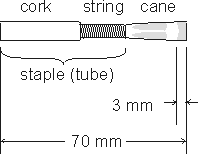Making Oboe Reeds
This section of my web site is very, very old. You can tell, because the photos are very small. But most of the information is still correct.
Introduction
This website illustrates the process of making oboe reeds. But first, some background information on reeds in general.
There are two kinds of reed instruments:
- Single reed (such as the clarinet and saxophone)
- Double reed (such as the oboe and bassoon)
These instruments, together with the flute (which uses no reed at all) make up the woodwind family.
Clarinet and saxophone players (who are considered very lucky by their double reed friends) can buy reeds that are machine-made and more-or-less ready for use right out of the box. These single reeds consist simply of a piece of cane which has been cut and machined to a particular shape. The reed is attached to a mouthpiece, typically made of plastic now.

Oboe and bassoon players, however, must usually make their own reeds. In an oboe's double reed, two pieces of cane are bound together and attached to one end of a metal tube (see diagram above). The other end of this assembly is inserted into the the oboe and forms an extension of its bore.
The behavior of the oboe reed is the primary factor in the oboe's quality of sound (pitch, tone quality, etc). The relative ease (or, more often, difficulty) which which it can produce a given note, at a given volume level, etc., is determined primarily by the reed as well.
Each oboist develops his/her own particular style or reed design. Since each player's embouchure and instrument is different, reeds made by one player are often not very playable by anyone else. The pictures shown here illustrate the style of reeds that I made*, developed over twenty years or so. The photos were taken long ago and probably don't show enough detail to illustrate much difference between my reeds and those of other oboists.
* Actually, I don't make reeds anymore. I barely have time to practice oboe, much less make reeds too. But now, lots of oboists sell reeds, so it's a little easier to find reeds that work for me. (Professional oboists almost always make their own, even today.)